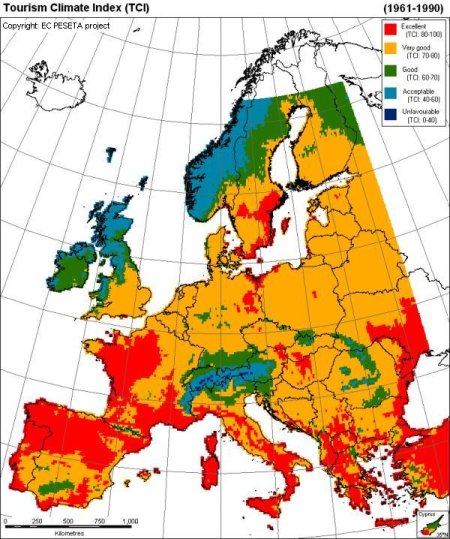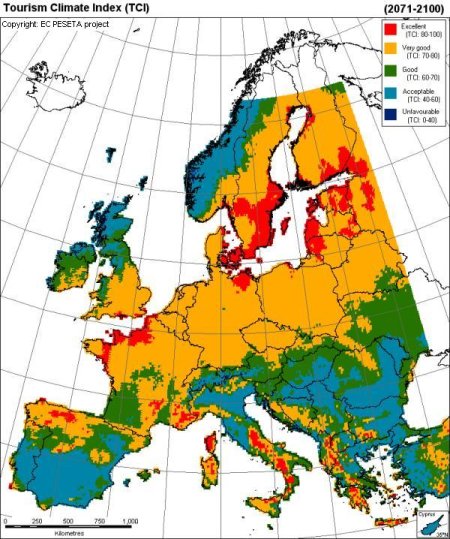4. Mass Tourism
Consequences of Climate Change on Tourism
Tourism flows between European countries depending on a wide range of factors, such as the income levels of tourists, transport costs, hotel prices, and the presence of cultural heritage and attractive landscapes. Climatic conditions also partly explain the spatial patterns and seasonal distribution of tourism in Europe. For instance, the large flow of north-European tourists to the Mediterranean regions in summer is largely explained by the pleasant thermal conditions. Coastal tourism, a dominant segment of the tourism market, has a marked seasonal and spatial concentration.
The climatic suitability for general summer tourism purposes can be expressed as an index, the Tourism Climate Index (TCI), comprising the climate features temperature, humidity, sunshine, rain and wind. Monthly climate data were used with a spatial resolution of 12 km. The maps represent summer conditions (June, July, and August).

Source: Peseta
Limitations of the approach: A number of limitations have to be taken into account when interpreting the information on the map. First of all, it is based on only one emission scenario and one climate scenario. Secondly, it is based on monthly climate data, and does not take into account extreme weather events, which may be important for tourism. Thirdly, there has been only limited validation of the index, mainly because of data limitations on the tourism side. Finally, and related to the third limitation, climatic suitability is only one of the influences on tourism patterns. Other crucial aspects should be considered in order to produce estimates of how tourist flows could change in the future, notably the income levels of the tourists and the price of the tourist services.
How to interpret the maps
The maps represent the summertime TCI scores in the baseline period (1961-1990) and towards the end of the century (2071-2100) in the IPCC A2 scenario (A2 describes a very heterogeneous world with high population growth, slow economic development and slow technological change, for more Information see www.ipcc.ch). The main information these maps provide is the direction of these shifts. Some regions see their climatic attractiveness improve in summer, with other regions facing deterioration. The maps indicate significant shifts in the climatic suitability for tourism, with the belt of excellent summer conditions moving from the Mediterranean towards northern Europe. In the shoulder seasons (Spring and Autumn, not shown here), TCI scores are generally projected to increase throughout Europe. In the Mediterranean region, excellent conditions may be attained in these seasons, which may compensate for some of the losses experienced in Summer.

Source: Peseta
Not too much confidence should be placed on the exact TCI values, due to the limitations noted above. The general changes in suitability patterns are the main message. The maps only provide projections of climatic suitability patterns, and not of the economic significance of climate change for tourism. The economic and societal relevance of climate change for tourism will crucially depend on adaptation strategies, which are largely unpredictable. Spatial adaptation (sticking to the same holiday period, choosing another destination) will produce very different results than temporal adaptation (sticking to the same destination, choosing another holiday period)(Peseta).
